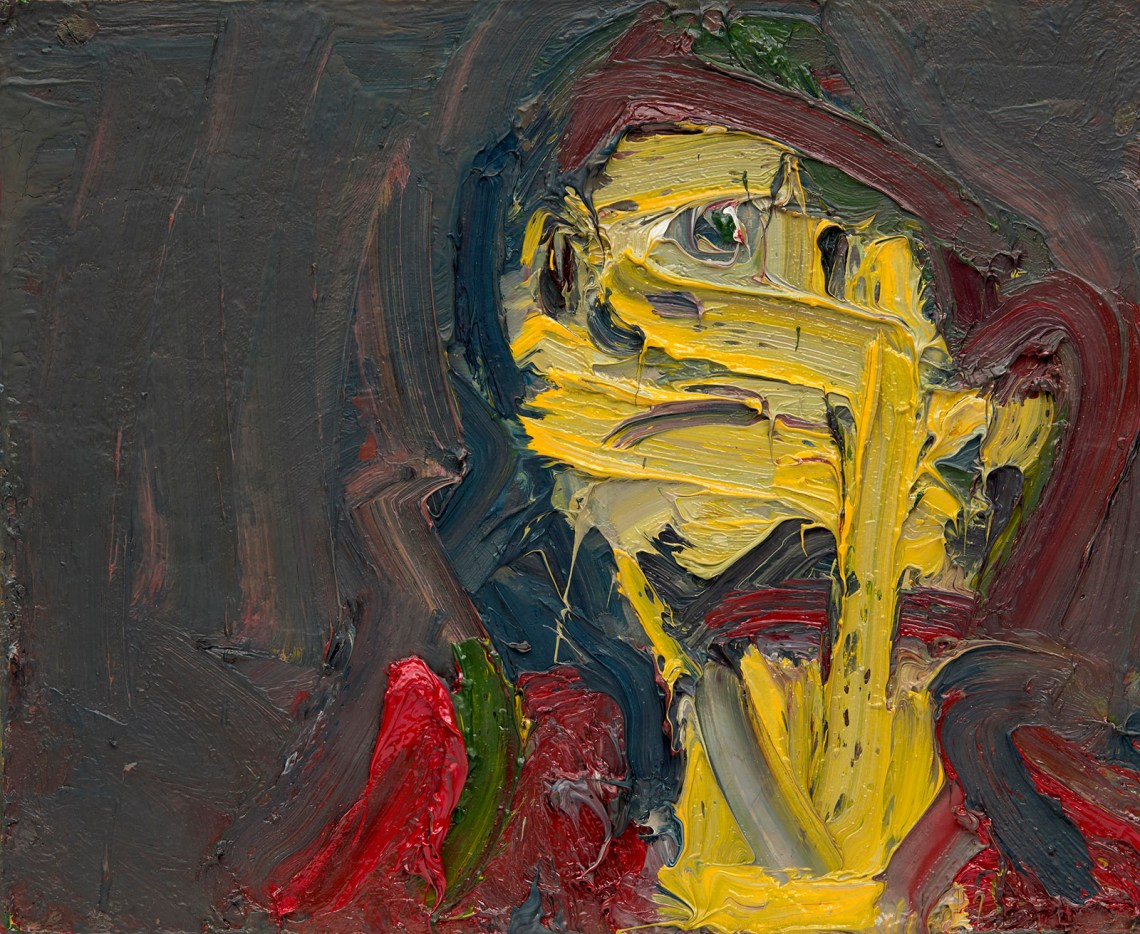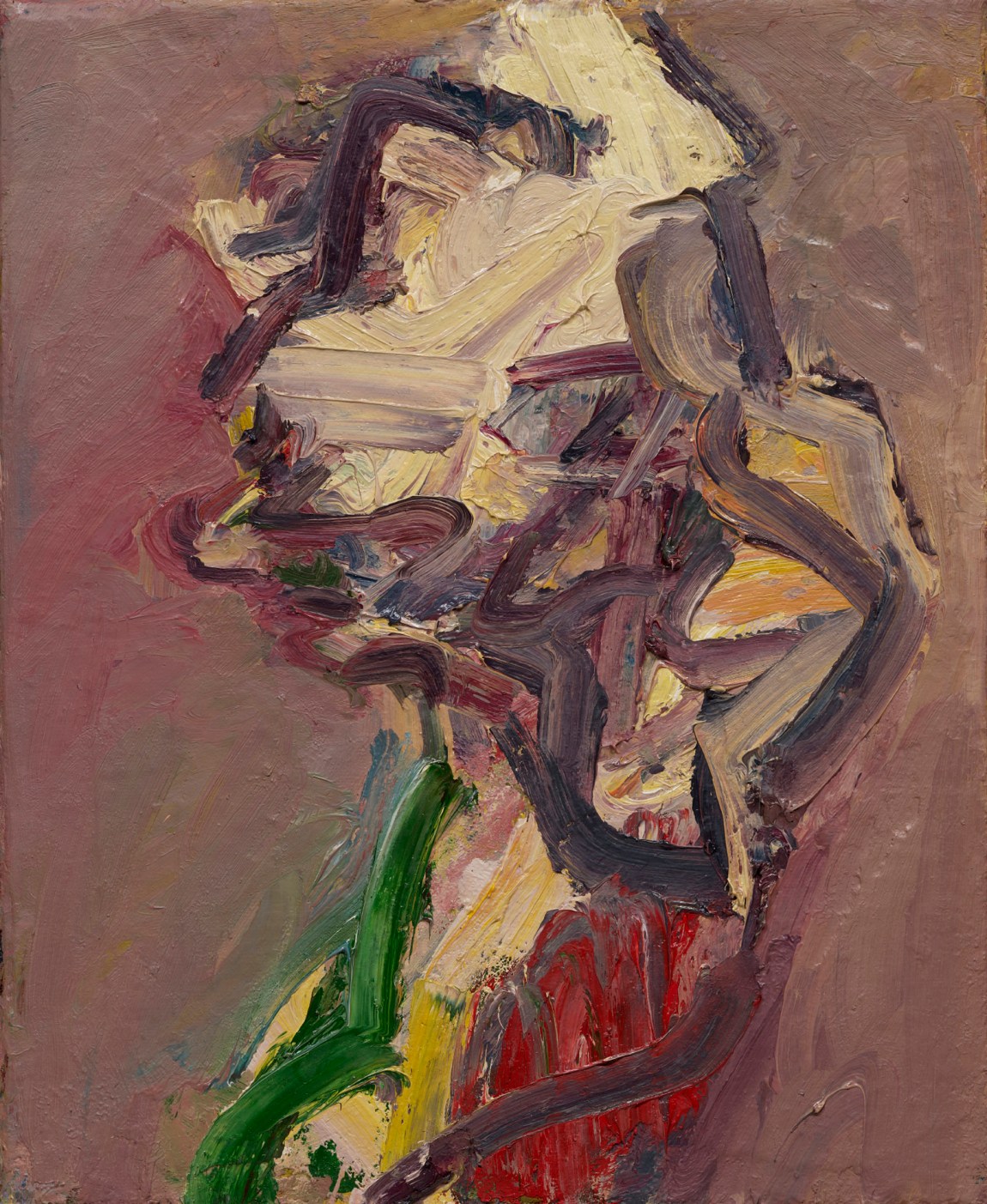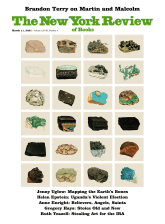The high points of the current New York gallery show of the eminent English painter Frank Auerbach are some dozen exquisitely colored and often bristling pictures of people seen from the neck up. Although the paintings include the name or initials of the sitter, more of the titles say “head” than “portrait,” and “head” is the right word, because Auerbach’s point seems to be less an intimate or psychologically aware account of his people than a use of their heads as pretexts to make paintings. We look at Julia (the artist’s wife), or Jake (their son), or Catherine Lampert (an independent curator and an authority on the artist), and see what appears to have been a mysterious and sometimes ferocious bout the artist had with his materials. It is mysterious because, while we are left with a sense of flying, eruptive energy, it is not clear why the artist came to make these particular jabbing or curving marks with his brush.
That Auerbach’s approach is far from realism can be felt in the way he adds, as if it were no more than last-minute signage, black blobs for nostrils or offhandedly drawn circles for eyes. A single firm line will do for a mouth. The breezily impersonal nature of these marks on a face—or, in a picture of a seated Lampert, the blunt way he outlines her legs and shoes—is pleasing in itself. We delightedly imagine hearing the artist say, as he adds his thick black directional lines, “Oh, here’s the person.”
The eyes and nostrils also give us our bearings. Standing before the powerful Head of J.Y.M. (1978) in the exhibition, I saw primarily an explosion of broad yellow brush marks and had little idea of what I was looking at. When I later saw the work in a reproduction, the features of the sitter’s face emerged, and I realized that the painting is of someone whose neck is tilted back. But finding the face hardly altered the tightly wound drama of Auerbach’s brushwork.
The Luhring Augustine exhibition presents an artist whose name has become almost synonymous with his single-minded dedication to the act of painting—and with, as an aspect of this, his stringent, monkish work habits. Soon to be ninety, Auerbach is known for working long hours in his studio every day and for being loath to move about London on any occasion, let alone travel outside the country. For years he has limited himself (with exceptions) to two subjects: the model before him, whom he usually needs to see again and again, and the streets, trees, and buildings of the area around Mornington Crescent and nearby Primrose Hill, a part of North London where he has worked since 1954. With paintings and drawings extending from 1978 to 2016, the current show starts when Auerbach had already firmly established his mature style, which might be thought of as a kind of personal expressionism. It is an expressionism that does not set out to show people or social life as ill or frightening, but rather renders the reality we all know with a choppy, urgent force.
Many of the works on view date from after 2000, when the artist was in his seventies and eighties, and in these pictures his approach is less pressured or embattled. In his more recent work, Auerbach’s paint surfaces are correspondingly less thick and luscious. His brush marks now land more delicately, like large confetti, and it is easier to see the head before us. But no matter how much or little paint he uses, Auerbach’s wonderful sense of color—whether it is silvery grays with emphatic black markings, greens and tan-blues running through big, muddy brushstrokes resembling the wave of a pompadour, or smoky lavenders touched with orange—never diminishes.
The exhibition is not, though, entirely successful. The two small Mornington Crescent pictures on view are, with their springtime reds, blues, and oranges, charming; but the city scenes that are four and five feet on a side, like a similarly big painting of people at a table with a cat looking on, are a bit dreary. Their color is not especially vibrant. That they do not make a strong impression may also derive from their being framed under glass, which seriously interferes with our being able to see them. The glazing, which the artist prefers, does not hurt the smaller “heads”—they are in the vicinity of twenty inches high—because we can get quite close to them. We don’t have to see ourselves (and the room behind us) when we look at the works, which unfortunately happens with the larger pictures under glass. On the other hand, the smaller pictures are set with a neutral-colored linen space between them and the frame, and this dilutes the tension or spring of the compositions.
Advertisement
Yet the show is a welcome event. It is the first the artist has had in New York since 2006, and it reminds us of Auerbach’s strengths. It sent me to reproductions of the painter’s earlier heads, figures, and London scenes. They can perhaps best be seen in William Feaver’s large-format, album-like Frank Auerbach (2009), which handsomely presents hundreds of pictures, dating from the 1950s, when the artist got underway, in what seems to be fairly accurate color. It includes a great number of paintings—mostly of heads but also of seated figures and female nudes, and often around two feet high or less—that are easily in a class with Head of J.Y.M. They are pictures in which Auerbach, looking at people straight on, from the side, or from below, continually outdoes himself in delectable color choices and displays of seemingly impromptu, brilliantly zigzaggy brushwork—displays that can leave a head resembling a piece of hacked wood, a wad of chewing gum, bodies wrestling, or an abstract shape recalling a bird’s nest.
Fine as the small Mornington Crescent paintings in the current show are, they do not seem quite comparable to Auerbach’s paintings of London sites from earlier decades. In, for example, the radiant Mornington Crescent with the Statue of Sickert’s Father-in-Law III, Summer Morning (1966), which is five feet wide, the street, sky, and walls of buildings are thickly painted in a rich uniform yellow, while railings, scaffolding, and light poles everywhere stand out with the same thick paint surfaces in fire-engine red, black, and, most surprisingly, baby blue. Each form is self-contained and of the same density as whatever is next to it, as in a piece of marquetry, except that where marquetry suggests a polished neatness, Auerbach’s forms are crackling and succulent.
Going through Feaver’s book, one also comes across seemingly atypical works that one hankers to see in person. Gaumont Cinema, Camden Town (1963), for instance, shows an auditorium crowded with moviegoers seen from above and somehow resembling a breathing, crumpled piece of orange terry cloth. On the screen is a black-and-white movie that seems to have been painted in blue tones. Study for St Pancras Steps, dated 1978–1979, gives us appealingly rough-hewn, marionette-stiff figures—my favorite suggests someone who has come from a Mexican Day of the Dead celebration—who make their way into the railway station. Urban life is here seen as a kind of masque, and one wishes Auerbach had explored it further.
Maybe most spectacular are two paintings, each over six feet high, entitled E.O.W., S.A.W. and J.J.W. in the Garden I and II. They are from, respectively, 1963 and 1964. Each presents a tall standing woman and smaller people behind her in such a staticky, wavy, when-will-this-image-come-into-focus way as to make us wonder if they are about poor TV reception. If that does not sound complimentary, I might say that the paintings could easily take their place with works by Walter Sickert, Luc Tuymans, Gerhard Richter, and Chuck Close that are exciting to the degree that they suggest we are seeing both reality and the slightly transformed way it can appear in a photograph or, in Auerbach’s case, on television.
Pictures like these make clear that in the United States Auerbach is long overdue for a first full look at all his work. He has been seen here in little more than occasional gallery shows in New York and, thirty years ago, a small exhibition in museums in St. Louis and New Haven of some of his London scenes. But if he is only somewhat known in the American art world, my sense is that he is an almost legendary figure for painters in many places. When, a few years ago, my nephew, a painter, came back from his first trip to London, he bubbled forth about all the art he saw, leading to the dramatic climax: “And guess who I saw walking in the street? Frank Auerbach!”
The artist’s importance certainly goes without question in England. He received major exhibitions in London in 1978, 2001, and 2015. In 1986 the painter shared the prestigious Golden Lion prize at the Venice Biennale with Sigmar Polke, and four years later Robert Hughes’s lengthy biographical and critical study, Frank Auerbach, authoritatively said that everything the artist had done was worthy of serious attention. Feaver’s abundantly illustrated volume reiterated that belief. And in 2015 Catherine Lampert brought out Frank Auerbach: Speaking and Painting, a biography that looks more closely at the terrain Hughes opened up, though in the format of a nicely designed, novel-size book. (It also happily lacks Hughes’s periodic use of Auerbach as a foil against New York painters of the 1980s whose work he found inauthentic.)
Advertisement
Yet one wonders how clear Auerbach’s art is even in the minds of his audience at home. Though the energy and beauty of his pictures are formidable, it is no easier in London than in New York to say what his art is about—to describe its mood and flavor, and say where it takes us. He has been grouped, with some rightness, with Francis Bacon and Lucian Freud, both of whom were older. All three were at different times close friends, and Bacon brought them together in his 1964 Double Portrait of Lucian Freud and Frank Auerbach. (Positioning their bodies and the furniture in his setting just so, Bacon amusingly makes it seem as if his two subjects are wearing only T-shirts.) Beginning in the 1970s, the three of them, along with a few other figurative painters, came to be thought of as a School of London. Like most such group titles, it was not something that the artists strove to create or put much credence in.
A “school” or not, these London artists stuck to the human figure (and to a lesser extent the city’s terrain) as their foremost subject matter during decades when most artists in New York made it seem as if abstraction, first in painting and later in sculpture, was the chief course open to challenging new art. The notion of a School of London gained ground because the artists were not only distinctive and imposing in their work but because, while any sense of storytelling or the tensions in human relations played no part in the art of the American Abstract Expressionists or of the Pop artists and Minimalists who followed them, such themes could certainly be felt in pictures coming from England. Freud’s clinically detached, almost pitiless realism left his sitters looking apprehensive when not totally drained, and Bacon, in the early (and I think lesser) stages of his work, when he painted popes and businessmen, showed people in states of barely controlled rage.
Auerbach’s paintings of heads, which in some instances appear literally mangled or, when they are turned to the side, to be expressing resignation, could be seen as adding a like-minded note to the work of the older artists. The faces and figures in all three painters’ pictures might be said to be managing, or barely managing, in stressful times. And in first coming to know Auerbach’s work, the details of his life story, which seemingly feed the idea that there is a bleak core to his art, are hard to keep out of your mind. Born into a German-Jewish family in Berlin in 1931 and an only child, he was sent for his safety to England in 1939, just before turning eight. And although he felt relatively at home in the school he was sent to, and did have some cousins in England, his isolation was compounded by his learning that within a few years of his arrival there his mother and father had been taken away and murdered in Auschwitz.
Without overdoing this grim and striking biographical information, Hughes described how it might have had a clear bearing on the painter’s work. Hughes felt that Auerbach’s immutable “habits as an artist” derived from a need for “security.” The painter’s “overriding sense of being alone in the world,” moreover, “would show in his attachment to the single, isolated figure, seen over and over again, re-imagined each time as unique and extraordinary.” Presenting Auerbach’s work with J.Y.M., the model he painted consistently for more than thirty years, Hughes wrote that over the course of the many paintings of this sitter, Auerbach “turned her into one of the most vivid personages in modern depictive art, transformed by repetition and re-seeing into a human icon as memorable as Giacometti’s wife Annette or his brother Diego.”
Yet Auerbach’s sitters, at least for this viewer, do not come off as unique, extraordinary, or vivid. While his models are identified, and in some of his more recent, and less powerful, heads we can feel that we have been given a sense of what Feaver, say, might look like, the people in his truly dynamic paintings, which more often are women, are hard to tell apart, and this is not offered as negative criticism. Our not feeling that there is a particular person behind Auerbach’s extraordinary brushwork—that his sitters are mannequins of a sort to him—may be part of what makes his work elusive, pliant, and beckoning. (This is quite different from Bacon’s paintings of the 1960s, which give not only the appearance of the person we look at but what their spirit meant to the artist.)
Perhaps the most unexpected aspect of Auerbach’s way of making a picture has to do with the combination of relentlessness and spontaneity that he brings to the job. As Lampert described it in 1986, when he is dissatisfied with a work on which he has spent a number of hours with a sitter, he scrapes off that day’s paint from his board or canvas and begins anew with the model’s next appointed visit. The approach goes along with our sense of an artist of dogged persistence. But Auerbach’s method also means that the result, the picture that we are now looking at, which might show brushwork of both intricate jabs and sweeping flourishes, has been done in one sitting. It is the work of a virtuoso who daily holds out for the precisely right handling of his brushes and paints. We are given the performance of a painter who, despite the aura of difficulty that adheres to his name, can sometimes remind us of Fred Astaire.





